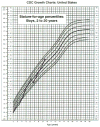Aggressive therapy improves cirrhosis in glycogen storage disease type IX
- PMID: 23578772
- PMCID: PMC3672367
- DOI: 10.1016/j.ymgme.2013.03.009
Aggressive therapy improves cirrhosis in glycogen storage disease type IX
Abstract
Glycogen storage disease type IX (GSD IX) is described as a benign condition that often does not require treatment. Most patients with the disease are thought to outgrow the childhood manifestations, which include hepatomegaly, poor growth, and ketosis with or without hypoglycemia. Long term complications including fibrosis and cirrhosis have seldom been reported in the most common subtype, GSD IXα. We present two cases of children with GSD IXα who had fibrosis at the time of diagnosis in addition to the commonly reported disease manifestations. Structured therapy with frequent doses of uncooked cornstarch and protein supplementation was initiated, and both children responded with improved growth velocity, increased energy, decreased hepatomegaly and improved well-being. Additionally, radiographic features of fibrosis improved. We propose that GSD IXα is not a benign condition. Even in patients with a less severe presentation, consideration of a structured treatment regimen to improve quality of life appears warranted.
Copyright © 2013 Elsevier Inc. All rights reserved.
Conflict of interest statement
Figures
References
-
- Hug G, Schubert WK, Chuck G. Phosphorylase kinase deficiency of the liver: deficiency in a girl with increased hepatic glycogen. Science. 1966 Sep 23;153(3743):1534–5. - PubMed
-
- Goldstein J, Austin S, Kishnani J, Bali D. Phosphorylase Kinase Deficiency. [Accessed November 26, 2012];GeneReviews at Gene Tests: Medical Genetics Information Resource. http://www.genetests.org.
-
- Burwinkel B, Rootwelt T, Kvittingen EA, et al. Severe phenotype of phosphorylase kinase-deficient liver glycogenosis with mutations in the PHKG2 gene. Pediatr Res. 2003;54:834. - PubMed
-
- Ban K, Sugiyama K, Goto K, Mizutani F, Togari H. Detection of PHKA2 gene mutation in four Japanese patients with hepatic phosphorylase kinase deficiency. Tohoku J Exp. 2003;200:47–53. - PubMed
Publication types
MeSH terms
Substances
Supplementary concepts
Grants and funding
LinkOut - more resources
Full Text Sources
Other Literature Sources
Medical


